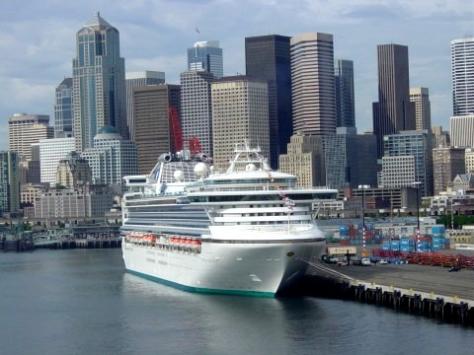
It's been a rocky year for the Port of Seattle.
On top of protests against the working conditions of short-haul truckers, the Port lost the Grand Alliance and Hamburg Sud lines to Tacoma, representing 20 percent of its container business. This at a time when the Northwest is not growing overall container market share and facing challenges from Prince Rupert, B.C., and the wider Panama Canal, opening in 2014.
The Port also decided to make a public fight against the proposed professional basketball arena in Sodo, jumping into a divisive issue.
Finally, it faced the blowback for allowing Chief Executive Tay Yoshitani to serve on the board of Seattle-based Expeditors International. Already earning almost $367,000 a year, Yashitani could take home an additional $230,000 as a director for a company at least indirectly involved in Port business.
But the Port can claim an unalloyed success with the cruise business. Although this year's traffic won't hit the record of 2010, it cements Seattle's place as a major cruise port. Before 2000, it barely merited a mention.
Nothing illustrates the dual character of the new hard times better than the cruise industry.
Even though Europe has slipped into recession and America is growing too slowly, the cruise business is booming.
According to a study released last week by Brea Business Research for the Cruise Lines International Association, a trade group, the industry grew strongly in both North America and Europe last year.
"The cruise industry is expanding at a rate well above the national average in overall economic activity and even above the travel and tourism industry," said Andy Moody, president of Brea. Although some of this can be attributed to its relatively smaller size as a sector, "this is an industry that can expand into the market, products and prices consumers are looking for."
In other words, these floating hotels can be shifted to ports and even continents where demand is high and ship size can be geared to market conditions. They can also change itineraries from, say, 11 days to three or four days.
Europeans are avid cruise-takers. European-cruise routes also attract American tourists. Although business has lately slowed, even the Mediterranean, ground zero of eurozone troubles, still enjoys strong cruise business, thanks to tourists with means.
Despite the Great Recession, millions have disposable income. It helps that plenty of retired Americans are able to spend money for the luxury of cruises.
For Seattle, that means going to Alaska, a route that is growing again after the state reduced a passenger head tax that had dampened cruise-ship visits.
Even with the Alaska tax, Seattle expects more than 864,000 passengers to embark here this year. That's down from 2010's record 931,698. But the passenger count in 1999 was 6,615.
Norwegian, Royal Caribbean and Celebrity, Holland America, Princess and Disney ships call at the Smith Cove Cruise Terminal.
Seattle has proved a continuous draw, starting with Norwegian in 2000 and adding Disney this year. The lines use 11 vessels, typically on weeklong voyages.
Oceania Cruises Regatta is expected next year, along with the Celebrity Solstice, which would be one of the largest cruise ships on the West Coast.
Cruise operations moved to Smith Cove in 2009 from Terminal 30, which is now a container facility operated by SSA and China Shipping. The new $72 million cruise terminal can load two ships at once, and has dockside power plug-ins so the ships can shut down their engines.
Attracting cruise lines was "a build it and they will come philosophy," Port spokesman Peter McGraw told me. Before Seattle went after the business, most Alaska-bound passengers embarked from Vancouver, B.C., which remains a rival.
In addition, 70 percent of passengers arrive through Sea-Tac Airport, which is also run by the Port. Many choose to spend a few days here before or after their cruise, a boon for retail, hotels, wineries and other attractions. "Seattle itself is a proven tourist draw," McGraw said.
The result of the cruise business is $416 million in annual business revenue locally, according to a Martin and Associates study commissioned by the Port. Each time a cruise ship docks, it means $2.1 million for the economy here.
Even if you're a skeptic of economic-impact studies, divide the numbers in half and you're still talking big money. All summer, nearly every time I'm out downtown, I give directions to somebody who's passing through on a cruise.
Nothing can be taken for granted. For example, California ports have suffered a decline in cruise business as fewer ships have been deployed on Mexico routes. Disney announced earlier this year that it will return to Vancouver next year.
"The cruise industry is very competitive," said Mike McGarry, vice president of public affairs for the trade association. "They try to continually come up with new itineraries, entertainment and cuisine. Shorter cruises are becoming a trend. In every case, they're competing with land-based resorts."
Still, just as the Port of Seattle doesn't have to be a mega-port in containers to succeed, neither is it as dependent on the cruise sector as Florida, which accounts for 40 percent of all passenger and crew visits in the nation.
Cruises are a valuable niche in a diversified portfolio of business.
We built it. They came and keep coming, adding another asset to the regional economy.
By Jon Talton, Special to The Seattle Times












Recommended Comments
There are no comments to display.
Join the conversation
You can post now and register later. If you have an account, sign in now to post with your account.